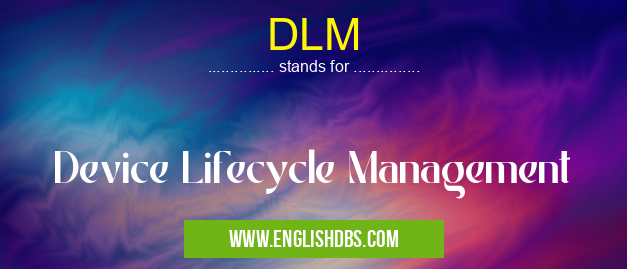What does DLM mean in MANAGEMENT
DLM stands for Device Lifecycle Management, a crucial aspect in managing the entire lifecycle of devices, such as laptops, desktops, smartphones, and other hardware, throughout their usage within an organization.

DLM meaning in Management in Business
DLM mostly used in an acronym Management in Category Business that means Device Lifecycle Management
Shorthand: DLM,
Full Form: Device Lifecycle Management
For more information of "Device Lifecycle Management", see the section below.
» Business » Management
What is Device Lifecycle Management (DLM)
DLM involves a comprehensive set of processes and policies that ensure the effective acquisition, deployment, maintenance, and disposal of devices in a secure and cost-efficient manner. It encompasses all stages of the device lifecycle, from planning and procurement to deployment, maintenance, retirement, and disposal.
Key Components of DLM
- Device Planning and Procurement: Determining device requirements, budgeting, vendor selection, and acquisition.
- Device Deployment: Configuring, installing software, and distributing devices to users.
- Device Management: Monitoring, maintaining, patching, and updating devices throughout their lifecycle.
- Device Security: Implementing security measures to protect devices from threats and data breaches.
- Device Support: Providing technical assistance and troubleshooting for device-related issues.
- Device Retirement and Disposal: Managing the secure retirement and disposal of devices, including data wiping and recycling.
Benefits of DLM
- Improved Device Security: Enforces security policies and mitigates security risks.
- Reduced Costs: Optimizes device lifecycle costs through efficient procurement, maintenance, and disposal practices.
- Increased Efficiency: Automates device management tasks, freeing up IT resources for other initiatives.
- Enhanced Device Performance: Ensures devices are properly maintained and up-to-date, maximizing performance.
- Improved Compliance: Meets industry regulations and standards related to device security and management.
Essential Questions and Answers on Device Lifecycle Management in "BUSINESS»MANAGEMENT"
What is Device Lifecycle Management (DLM)?
Device Lifecycle Management (DLM) is a comprehensive approach to managing the entire lifecycle of devices used in an organization, from initial procurement to final disposal. It involves planning, deploying, securing, and retiring devices in a systematic and efficient manner.
Why is DLM important?
DLM helps organizations optimize device usage, reduce costs, ensure security, and improve employee productivity. By effectively managing devices throughout their lifecycle, organizations can ensure that they are always available, secure, and compliant with regulations.
What are the key components of DLM?
Key components of DLM include device procurement, deployment, asset tracking, security management, software updates, end-of-life planning, and data disposal. Each component plays a vital role in ensuring that devices are managed efficiently and securely throughout their lifespan.
How can DLM help organizations reduce costs?
DLM can help organizations reduce costs by optimizing device purchasing, extending device lifespans, and reducing the risk of data breaches and compliance violations. By effectively managing devices, organizations can avoid unnecessary expenses and maximize the value of their device investments.
How does DLM improve security?
DLM helps improve security by providing a systematic approach to device security management. It includes regular software updates, security patching, and remote device management capabilities. By proactively managing device security, organizations can reduce the risk of data breaches and other security incidents.
How does DLM benefit employees?
DLM benefits employees by providing them with reliable and secure devices that are always up-to-date. By effectively managing devices, organizations can reduce downtime, improve productivity, and enhance employee satisfaction.
Final Words: DLM plays a vital role in optimizing device management within organizations. By implementing comprehensive DLM practices, businesses can improve security, reduce costs, enhance efficiency, and ensure device performance and compliance.
DLM also stands for: |
|
| All stands for DLM |
